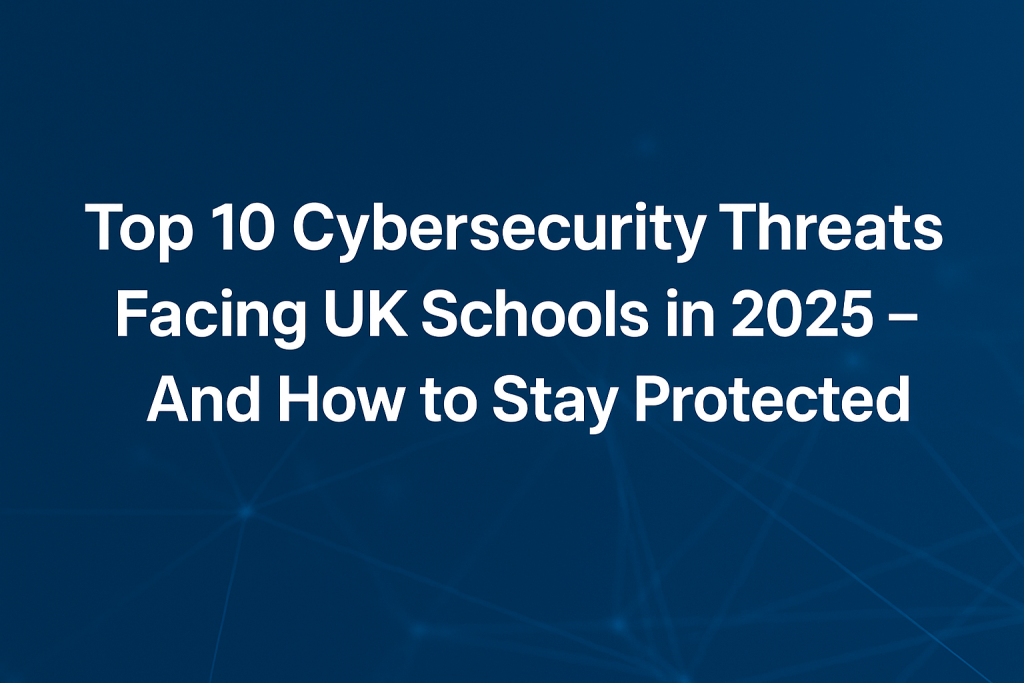In 2025, UK schools and educational institutions remain prime targets for cybercriminals. With growing reliance on digital platforms, cloud storage, and remote access tools, the education sector is more exposed than ever. Understanding the top cybersecurity threats is the first step towards securing your digital environment.
Here are the top 10 cybersecurity threats facing schools in 2025 – and how to protect your institution from them:
1. Phishing Attacks – Cybersecurity threat
Phishing emails often target school staff and students, tricking them into revealing login credentials or clicking on malicious links. With AI-generated phishing becoming more convincing, vigilance is key.
Protective Measures:
- Regular staff and student training
- Email filtering solutions
- Multi-factor authentication (MFA)
2. Ransomware
Ransomware attacks can lock down entire school systems, encrypting data and demanding payment. Schools are particularly vulnerable due to budget constraints and legacy systems.
Protective Measures:
- Regular off-site backups
- Up-to-date antivirus and endpoint protection
- Network segmentation
3. Unsecured Remote Learning Platforms
Post-COVID, remote and hybrid learning environments have become permanent. Poorly secured platforms can be exploited, exposing sensitive student data.
Protective Measures:
- Use of secure, verified platforms
- Access control policies
- End-to-end encryption
4. Weak Password Policies
Many breaches occur due to weak or reused passwords by staff and students.
Protective Measures:
- Enforce strong password policies
- Encourage password managers
- Implement regular password updates
5. IoT Vulnerabilities (Smart Devices in Classrooms)
Interactive whiteboards, smart cameras, and other IoT devices can serve as entry points for cyberattacks.
Protective Measures:
- Keep device firmware updated
- Isolate IoT devices on a separate network
- Disable unused ports and services
6. Data Breaches and Insider Threats
Breaches can stem from both external hackers and internal negligence or malicious insiders.
Protective Measures:
- Role-based access controls (RBAC)
- Monitoring tools and activity logs
- Clear data handling policies
7. Social Engineering
Attackers may manipulate school staff over the phone or through social media to gain access to internal systems.
Protective Measures:
- Awareness campaigns
- Verification procedures before disclosing information
- Regular penetration testing
8. Third-Party Software Risks
Educational apps and plugins can introduce vulnerabilities if not properly vetted.
Protective Measures:
- Conduct due diligence before adoption
- Restrict unnecessary integrations
- Regularly update and patch third-party tools
9. Lack of Cybersecurity Awareness Among Students
Students often lack awareness of safe online practices, putting entire systems at risk.
Protective Measures:
- Integrate cyber safety into the curriculum
- Use gamified cybersecurity learning tools
- Encourage reporting of suspicious activity
10. Inadequate IT Support and Resources
Schools with limited IT staff struggle to maintain robust cybersecurity.
Protective Measures:
- Partner with managed IT service providers
- Conduct regular cybersecurity audits
- Seek government or private sector support programmes
Final Thoughts on Cybersecurity
Cybersecurity in education is no longer optional – it’s essential. With cyber threats becoming more advanced and targeted, UK schools must adopt a proactive approach to digital safety.
At CDN Networks, we help educational institutions across the UK implement affordable, effective, and scalable cybersecurity solutions. Whether you need a network audit or a fully managed security service, we’re here to help.
Let’s build a safer digital future for our schools.
Worried about your school’s cybersecurity? Get in touch with CDN Networks for a free risk assessment and expert advice tailored for UK educational institutions.


